

 The South African
The South African
The South African Navy celebrated a notable achievement on 23 May 2022, when its Hecla class hydrographic survey vessel, SAS Protea reached fifty years in service – the first ever South African naval vessel to do so. The Bar-class boom defence vessel SAS Somerset and the Ton-class minesweeper SAS East London minesweeper had accumulated 43 years of service. But – compared to other ships of the Navy – the Protea had a particularly active and uninterrupted period of service.
Since 1922, five hydrographic survey vessels have been service of the South African Hydrographic Office which has played a leading role in the international field of hydrography for several years. A former SA Navy hydrographer, Captain Abri Kampfer was awarded the international Alexander Dalrymple Prize in 2009 and currently serves as director of the International Hydrographic Organization in Monaco.
Four Proteas
The South African Naval Service (SANS), established on 1 April 1922, is widely regarded as the forerunner of the South African Navy. It is significant that one of the first vessels that the SANS acquired in 1922 was a hydrographic survey vessel HMSAS Protea, formerly HMS Crozier. The first Protea continued this task for more than ten years until the drastic economic consequences of the Great Depression in the early 1930s forced the SANS to decommission the vessel. The situation was so dire that the SANS virtually ceased to exist.
The outbreak of the Second World War in September 1939 however led to a rapid naval expansion and the establishment of the Seaward Defence Force and subsequent SA Naval Forces (SANF). Hydrographic work was temporarily suspended during the war years and the second vessel bearing the Protea name was an anti-submarine vessel, one of many commercial whalers and fishing trawlers converted to serve in the SANF. HMSAS Protea (ii) served in the Mediterranean and on 11 July 1942 – in a joint effort – attacked and sank the Italian submarine Ondina. The battle honours that were consequently awarded to this vessel have since been carried forward to the other Proteas.
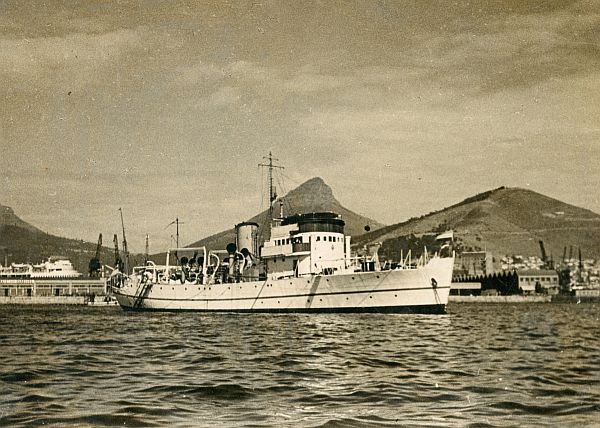
The third Protea – (HM)SAS Protea (iii) that served
as the Navy’s hydrographic survey vessel from 1950 to 1957.
(SA Naval Museum)
The post-war SA Navy again continued hydrographic survey work after the former corvette, HMS Rockrose, was acquired and rebuilt in Durban for this purpose. SAS Protea (iii) rendered valuable service from 1950 but was replaced after only seven years by another converted vessel, the former Loch-class frigate, SAS Natal, due to obsolete technology. A Ford-class seaward defence boat, SAS Haerlem was similarly converted to an inshore survey vessel in 1963 to support the Natal and continued in that capacity until 1985.
Built in Scotland
A close association was renewed in 1969 when a contract was signed between the South African government and Yarrow Shipbuilders for the construction of the Navy’s first purpose- build hydrographic survey vessel. Yarrow had also built two of the three Type 12 frigates, the SAS President Kruger and President Pretorius for the South African Navy in the early 1960s. Amidst the South African government's policy of apartheid, growing isolation and looming arms boycotts, the new Hecla-class hydrographic survey vessel was in fact the last British-built ship that would be built for the SA Navy.
A SAN project team left for Glasgow at the end of 1969 to oversee the construction of the new ship. The keel of the new vessel was laid down in March 1970, but construction was repeatedly interrupted due to persistent strikes at the shipyard. On 4 July 1971 the new vessel was launched on the River Clyde and christened the SAS Protea -the fourth ship to bear that name.
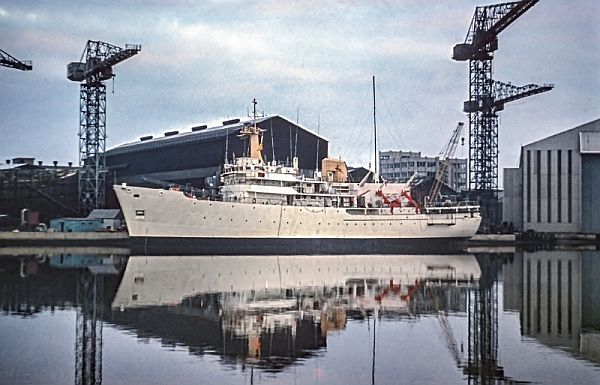
SAS Protea moored at the Yarrow shipyard
on the river Clyde on 19 February 1972.
(SA Naval Museum)
The new vessel cost the government R6 million, but was in all respects a major improvement on the old SAS Natal which was withdrawn from service in March 1972. The new ship was 79.25 m long, 14.94 m wide with a full load displacement of 2 750 tons and was powered by four 12-cylinder Paxman Ventura diesel engines (replaced in 1996 by four 12-cylinder MTU diesels) giving it a top speed of 16 knots and a range of 12 000 nautical miles at 12 knots. The vessel was not armed, but equipped with a flight deck and hanger, large enough for a single Wasp or Alouette helicopter. As with other hydrographic vessels, the hull was painted white and in later years the Protea was fondly referred to as “the white lady”. The crew consisted of 18 officers and 114 sailors which included 45 Coloured members of the South African Cape Corps, one of the first instances of racial integration on ships of the SAN.
Under the watchful eye of the Yarrow shipyard, sea acceptance trials commenced in early May. After the necessary tests and technical adjustments, the SAS Protea was officially handed over to the SAN and commissioned on 23 May 1972 under the command of Captain Arthur Fawthrop. The ship sailed to Portland naval base where it completed the necessary operational sea training evaluation. On 6 June the bow was turned southwards for the long voyage to South Africa with ports of call at Lisbon, Las Palmas, Luanda and Walvis Bay, before its arrival in Simon’s Town on 14 July 1972.
Remote islands and Antarctica
Apart from the primary task as a hydrographic survey vessel, the vessel performed a wide variety of tasks and proved to be one of the most versatile in SAN service. Its long range, ability to navigate in ice, cargo capacity and helicopter on board made it most suitable to sail to the remote islands of the South Atlantic and Southern Ocean. Shortly after the ship returned home in 1972, it sailed to Tristan da Cunha to provide medical supplies and assistance to the isolated inhabitants on the island. The first of many visits to Marion Island followed in 1974 when a number of observation huts were placed on the island for scientific research purposes. In 1977 SAS Protea sailed into the roaring forties again, this time for hydrographic survey work, but also to curb a troublesome cat plague on the island. An international krill research project then took the Protea further south to Antarctica in February 1978 and in the process the first SAN ship to sail around the notorious Cape Horn. More voyages to Marion followed in later years (see below), but in January 1994 the Protea again sailed south to Antarctica and Bouvet Island, in the process, with the first SAN female officer to ever cross the Antarctic on board.
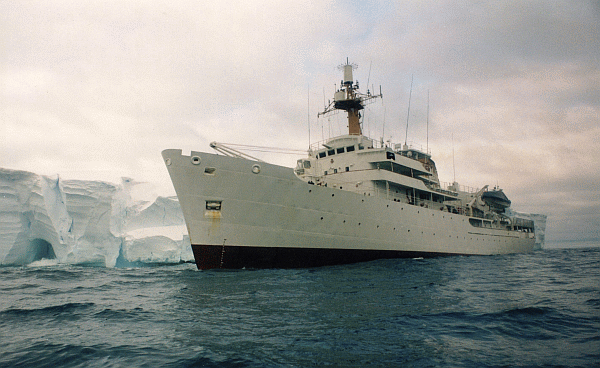
SAS Protea in Antarctica, January 1994
Humanitarian aid
The prestigious SAN Sword of Peace was awarded to Protea on three occasions in recognition of the ship's role in search and rescue operations. The first occurred in May 1978 when 26 crew members of the stranded Japanese fishing trawler, the Kayo Maru were rescued along the inhospitable coast of South West Africa. In July 1984, the Protea was sent to Marion Island again, this time to bring the seriously ill leader of the research team back to South Africa for medical care. The third award was made in 2005 after the Protea rescued the crew of the cargo vessel Kiperousa, which had foundered off Port Alfred.
A very important person on board
“The white lady” always looked the part and was well dressed on special occasions, especially when presidents and other dignitaries were welcomed on board. Presidential naval reviews were held in 1988, 1992, 1997 and 2008 and the Protea was a most suitable review vessel from which four different presidents observed the ceremonial passing of naval vessels and answered the salute. On the occasion of the 1997 International Navy Review in Table Bay, which coincided with the Navy's 75th anniversary – forty-seven ships, including 22 warships from 13 countries, were part of the sail past and most appropriately, President Nelson Mandela was on board SAS Protea during this prestigious event.
A true ambassador: flag showing cruises
The Protea visited no fewer than 16 international destinations in the first seven years of service, but the government's persistent policy of apartheid and the subsequent international opposition and isolation limited the Navy to its own ports for most of the 1980s with few opportunities for international flag showing cruises. Thankfully, a “change in course” occurred in February 1990 following President FW de Klerk's important "watershed speech". This paved the way for political reform in the country and South Africa was soon welcomed back into the international fold. Just two months later SAS Protea left Simon’s Town for Portugal as the guard ship of the 1990 Portnet Dias yacht race. It was the first time in eighteen years that a SAN ship had visited Europe and the first of many subsequent flag showing cruises. The Navy was invited to participate in the International Hydrographic Organization Conference in Monaco in May 1992. During an extensive 82-day overseas voyage, SAS Protea sailed through the Strait of Gibraltar to Monaco, from where it also docked in Genoa, Istanbul, Constanta and sailed back through the Suez Canal to Simon's Town. The SAN had renewed old ties and made new friends along the way. As new vessels were put into service especially the icebreaker SAS Outeniqua and four Valour-class frigates - the opportunities for the Protea became less frequent, but the vessel was still able to visit Rio de Janeiro in April 2000 to take part in the Brazilian international naval revue. The last notable international voyage was undertaken in February 2008 to sail with the new submarine, SAS Queen Modjadji I, from Germany, but the old lady was starting to show her age.
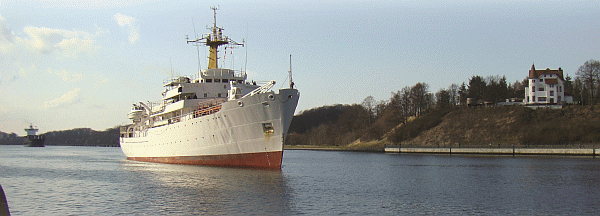
SAS Protea transiting the Kiel Canal,
Germany, March 2008
(SA Naval Museum).
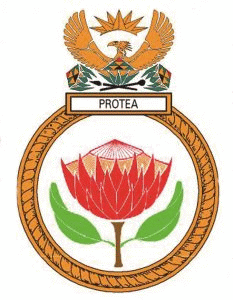
The Crest badge of SAS Protea
Operations in Mozambique Channel
The SA Navy has been committed to Operation Copper since 2011, which sees to the maritime patrol and surveillance of the Mozambique Channel to curb the threat of pirate activities from the north. Initially, the new frigates were used on a rotational basis, but the latter use of the smaller Warrior-class offshore patrol vessels proved to be a more economical option. In order to support these vessels at sea, SAS Protea was sent to the area in July 2018. The Protea's presence ensured a successful and more sustained operation during which a larger area could be patrolled.
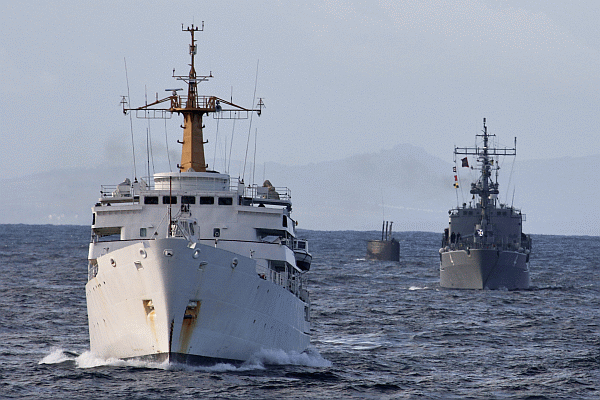
SAS Protea during the international maritime exercise
Atlasur XI in September 2018.
(Dean Wingrin)
A replacement on the way
A replacement for the 50-year-old Protea is currently being built in Durban at the Sandock Austral Shipyards - the same shipyard that also built the SAS Drakensberg, six strike craft and two minehunters for the navy in the 1980s. The new 95-meter vessel of approximately 4,000 tonnes is based on the Vard 9 105 design – an evolution of the hydrographic survey vessels, HMS Echo and Enterprise. SAS Protea will continue in service as a training ship for the time being, while the new hydrographic vessel is put into service.
Sources:
About the author
Commander Leon Steyn is the Officer-in-charge of the South African Naval Museum in Simon’s Town and a masters(Mil) candidate in the Department of Military History at the Faculty of Military Science of Stellenbosch University. His thesis focuses on the human transformation of the South African Navy between 1957 and 1994.
THE SAS Protea LAUNCHING MALLET
The South African Naval Museum continued to observe 50 years of the hydrographic survey vessel’s service during 2022. In October the museum received a donation with a special link to the ship. SAS Protea was launched and christened on 14 July 1971 at Yarrow Shipbuilders in Glasgow, Scotland. At this event the little wooden launching mallet that sent the big ship down the slipway into the River Clyde was gifted to the the sponsor or "godmother" of the ship, wife of Commandant General Rudolph Hiemstra. Mrs Gertie Hiemstra. Seen in the photo is Sir Eric Yarrow of Yarrow Shipbuilders and Mrs Hiemstra with the little mallet in hand. The newly launched Protea can be seen floated in the background.
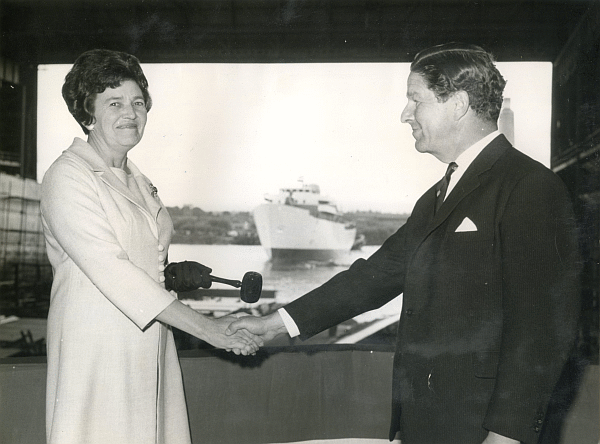
Sir Eric Yarrow of Yarrow Shipbuilders and Mrs Hiemstra with the little mallet in hand
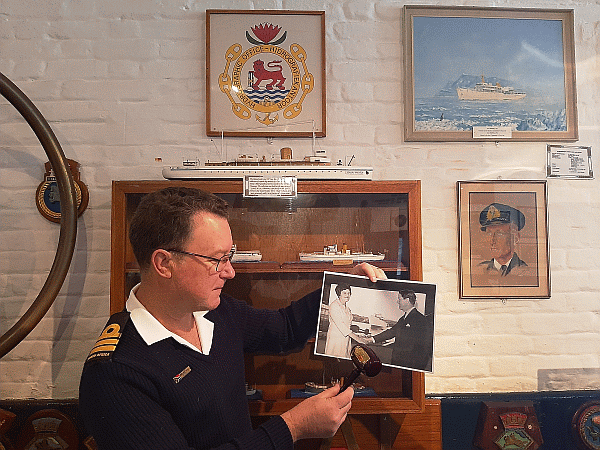
The curator of the SA Naval Museum, Cdr Leon Steyn with the mallet.
We thank the Hiemstra family for this kind donation to the Naval Museum. The mallet will be added to the SAS Proteadisplay, for all our museum visitors to appreciate.
Return to Journal Index OR Society's Home page
South African Military History Society / scribe@samilitaryhistory.org